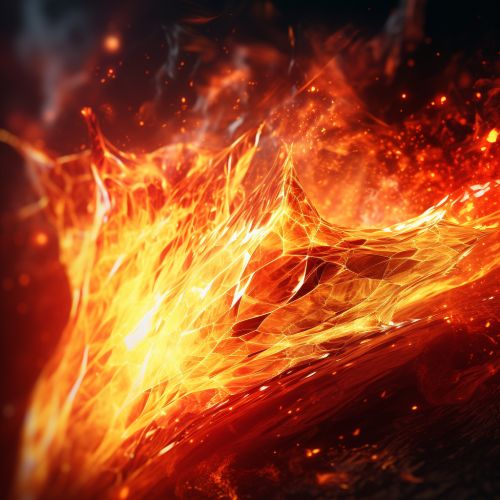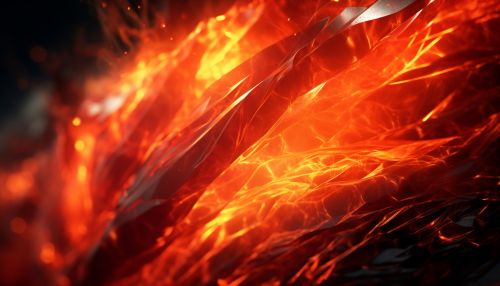Spark
Introduction
A spark is a small fiery particle or ember that is emitted from a fire, typically one that is produced by striking together two hard surfaces such as stone or metal. Sparks are an important phenomenon in the fields of physics, chemistry, and engineering, and understanding their properties and behavior can have significant implications in a variety of applications.


Physics of Sparks
Sparks are the result of a process known as electrical breakdown, which occurs when the electric field in a medium (such as air) becomes strong enough to accelerate free electrons to velocities that can knock other electrons off atoms, ionizing them and creating more free electrons. This process can rapidly create a conductive path through the medium, allowing an electric current to flow and producing a spark.
Generation of Sparks
Sparks can be generated in a number of ways. One of the most common methods is through the process of tribology, which involves the interaction of surfaces in relative motion. This can include processes such as friction, wear, and lubrication. When two hard surfaces are struck together, the energy of the impact can cause small particles to be ejected from the surfaces. These particles can become heated to high temperatures, producing a spark.
Another common method of spark generation is through electrical discharge, such as in a spark plug in an internal combustion engine. In this case, a high voltage is applied across a small gap, causing the air in the gap to ionize and form a conductive path. The resulting spark can ignite the fuel-air mixture in the engine, driving the combustion process.
Properties of Sparks
Sparks have a number of distinctive properties that make them unique. They are typically very bright, due to the high temperatures involved in their formation. This brightness can make them useful in applications such as lighting and signaling.
Sparks are also typically very short-lived, lasting only a few milliseconds. This is due to the rapid cooling of the particles involved in the spark, which causes them to quickly lose their energy and cease to glow.
Chemistry of Sparks
The chemistry of sparks is complex and involves a number of different processes. At the most basic level, a spark involves the rapid oxidation of material in a high-temperature environment. This oxidation process is what gives a spark its characteristic brightness.
Oxidation Process
When a spark is generated, the high temperatures involved cause the rapid oxidation of the material being sparked. This oxidation process involves the reaction of the material with oxygen in the air, producing heat and light. The heat produced by this reaction can further accelerate the oxidation process, leading to a self-sustaining reaction that continues until the material is consumed or the temperatures drop below a certain threshold.
Ionization
In addition to the oxidation process, sparks also involve a significant amount of ionization. This is due to the high temperatures and electric fields involved in spark formation, which can strip electrons from atoms and create ions. These ions can then recombine with electrons, releasing energy in the form of light. This ionization process is what gives sparks their characteristic blue or purple color.
Applications of Sparks
Sparks have a wide range of applications in various fields. They are used in a variety of devices and processes, from simple tools like lighters and sparklers to complex systems like internal combustion engines and electrical power systems.
Ignition Systems
One of the most common applications of sparks is in ignition systems, such as those found in internal combustion engines. In these systems, a spark is used to ignite a fuel-air mixture, driving the combustion process that powers the engine. This is typically accomplished using a spark plug, which generates a spark across a small gap when a high voltage is applied.
Lighting and Signaling
Sparks are also commonly used in lighting and signaling devices. For example, sparklers are a type of firework that uses a slow-burning spark to produce a bright, long-lasting light. Similarly, flares use a spark to ignite a mixture of chemicals that produce a bright, intense light that can be seen from a great distance.
Electrical Systems
In electrical systems, sparks can be both a useful tool and a potential hazard. On the one hand, sparks can be used to create electrical connections, such as in arc welding, where a spark is used to melt metal and create a strong, durable bond. On the other hand, sparks can also cause damage to electrical equipment and pose a fire risk, particularly in environments with flammable materials.
Safety Considerations
While sparks can be useful in a variety of applications, they also pose certain risks that must be carefully managed. Sparks can cause fires if they come into contact with flammable materials, and they can cause injury if they come into contact with the skin or eyes. Therefore, it is important to take appropriate safety precautions when working with sparks.
Fire Safety
One of the primary risks associated with sparks is the potential for fire. Sparks can easily ignite flammable materials, and even a small spark can start a large fire if conditions are right. Therefore, it is important to keep sparks away from flammable materials and to have appropriate fire safety measures in place when working with sparks.
Personal Safety
Sparks can also pose a risk to personal safety. They can cause burns if they come into contact with the skin, and they can cause eye injuries if they are not properly shielded. Therefore, it is important to wear appropriate protective equipment when working with sparks, such as safety glasses and fire-resistant clothing.
